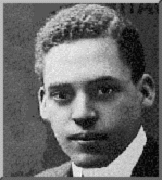 Ernest
Everett Just (1883-1941)
Ernest
Everett Just (1883-1941)
Ernest Everett Just was a true scholar. He sought to find "truth" using scientific methods and inquiry. Although Dr. Just was bold enough to challenge the theories of leading biologists of the 19th and 20th centuries, he was humble and unassuming. Dr. Just was passionately driven to understand the world of the cell. His tenacity and motivation led him to add to our understanding of the process of artificial parthenogenesis and the physiology of cell development.
Dr. Just was born August 14, 1883 in Charleston, South Carolina. At an early age, he demonstrated a gift for academic research. For example, in 1907, he was the only person to graduate magna cum laude from Dartmouth College with a degree in zoology, special honors in botany and history, and honors in sociology.
Immediately after graduation, Dr. Just taught at Howard University where he was appointed head of the Department of Zoology in 1912. At Howard, he also served as a professor in the medical school and head of the Department of Physiology until his death. The first Spingarn Medal was awarded to the reluctant and modest Just by the NAACP in 1915 for his accomplishments as a pure scientist. In 1916, Dr. Just gradutated magna cum laude from University of Chicago receiving his doctorate in experimental embryology.
Dr. Just received international acclaim for work he completed during the summers from 1909 to 1930 at the Marine Biological Laboratory (MBL) in Woods Hole, Massachusetts. At MBL, he conducted thousands of experiments studying the fertilization of the marine mammal cell. In 1922, he successfully challenged Jaacque Loeb's theory of artificial parthenogenesis, pushing the envelope. Using his research conducted at Wood's Hole, he published his first book entitled, Basic Methods for Experiments on Eggs of Marine Mammals.
Although Dr. Just was considered a leader and authority for his work with cell development, as an African American, he experienced racism and prejudice. For this reason, Dr. Just decided to study in Europe in 1930. It was in Europe that he published his second book, The Biology of the Cell Surface. While in Europe in 1938 he published a number of papers and lectured on the topic of cell cytoplasm. Dr. Just died October 27, 1941 in Washington D.C.
Designed by: Gingi Folayan Wingard
Brown, Mitchell. Ernest Everett Just. [Online]. Brown, M. (Webmaster). Available http://www.lib.lsu.edu/lib/chem/display/just.html. August 20, 1997.
Hayden, Robert C. (1970) Seven Black American Scientists. Reading, MA:Addison-Wesley.
UnitedStates Postal Service. Marine Biologist- Ernest E. Just 19th Honoree in Black Heritage Stamp Series. [Online]. Available http://www.usps.gov/news/stamps/96/96006stp.htm. January 18, 1996.